Can we help you?
Contact us

Can we help you?
Contact us

Thank you for contacting us
Your form has been submitted successfully Our team will contact you again as soon as possible.
Whooppss...!! An error has occurred
Try sending later or write an email directly to areaempresas@ua.es

 PATENTED TECHNOLOGY
PATENTED TECHNOLOGY
INFO
SHEET
DOWNLOAD
EXECUTIVE
ABSTRACT
CONTACT DETAILS: Research Results Transfer Office-OTRI
University of Alicante
Tel.: +34 96 590 99 59
Email: areaempresas@ua.es
http://innoua.ua.es
The Carbon Materials and Environment Research Group of the University of Alicante has developed a new method for obtaining carbon materials with excellent properties such as electrocatalysts in fuel cells or metal-air batteries. The process is based on the thermal treatment of polyaniline (or its derivatives) at high temperature and allows to obtain metal-free carbon materials with a high performance, in a very simple, fast way and in a single stage. These novel materials are characterized by their excellent catalytic activity and selectivity in the oxygen reduction reaction in alkaline medium, they are very stable and resistant to methanol and carbon monoxide poisoning, and above all, they stand out for their low manufacturing cost, which makes them promising candidates to replace the current commercial platinum-based catalysts. We are looking for companies interested in acquiring this technology for commercial exploitation.

Fossil fuels are commonly used to generate the energy needed to satisfy the world's energy demand. However, their excessive consumption has two important consequences: first, they are not unlimited resources, so they will be depleted in the medium term; and second, they cause serious damage to human health and to the environment (global warming, acid rain, photochemical smog, etc.).
It is essential to find new forms of energy generation that reduce the harmful effects of fossil fuels and increase the energy efficiency of the devices used.
In this sense, hydrogen-based energy systems are the great candidates for solving these problems. In fact, fuel cells have positioned themselves as the main system of the future for the automobile industry, and for the storage and use of renewable energies.
In this system, the global reaction is a consequence of the individual reactions that occur in the electrodes: in the anode, there is oxidation of the fuel (hydrogen, methanol, ethanol, etc.), and in the cathode, the reduction of the oxidizing agent (oxygen or air). The electrodes are separated by a selective ion exchange membrane.
In fuel cells, unlike batteries, fuel is continuously fed by an external source at the anode, where protons (which migrate through the membrane to the cathode to recombine with reduced oxygen species to form water, which is expelled from the cell) and electrons (which migrate through collectors to the cathode performing useful work that results in an electric current) are generated.
Currently, the performance and efficiency of fuel cells are not optimized. The main limiting factor is the use of platinum as a catalyst to accelerate electrode reactions. Platinum is a scarce metal (there is not enough platinum to satisfy the demand of the entire world vehicles fleet), it has a high cost, platinum nanoparticles agglomerate during use (which causes a significant reduction in its catalytic activity), and the presence of small traces of carbon monoxide or methanol can completely poison the catalyst, rendering it unusable.
Most of the platinum of the fuel cells (almost 90%) is used in the cathode due to the low rate of the oxygen reduction reaction, making this reaction the main limiting factor for these devices.
A major research effort is being made to obtain new materials for replacing or removing platinum from the cathode. For this, it is being studied:
1) Other alternative metals of higher abundance and lower cost: for instance, gold, silver, palladium, cobalt, nickel, iron, magnesium, chromium and vanadium, although the resulting catalyst still has a high cost, and the nanoparticles of the metals agglomerate, resulting in a loss of catalytic activity, and therefore, low durability.
2) Metal-free catalysts: this innovative type of metal-free catalysts radically reduces the cost of the electrode and can even increase the efficiency of fuel cells. Unfortunately, this type of catalysts do not currently meet the cost reduction target because they use very expensive precursors (e.g. graphene) and because the synthesis procedure involves many long and costly stages so that the price of the resulting electrocatalyst rises to values close to commercial platinum-based values.
Within the group of metal-free catalysts, carbon materials stand out. Interestingly, their surface chemistry can be modified to introduce heteroatoms, for example nitrogen, thus obtaining new materials whose behaviour is very interesting in the oxygen reduction reaction.
Although there are different methods to synthesize these materials, the carbonization of a material rich in nitrogen (for example polymers that contain nitrogen in its polymeric chain), has the advantage that the starting compound (precursor) has a defined chemical structure and it can be synthesized through different chemical processes.
There are conductive polymers with a high nitrogen content (e.g. polyaniline and polypyrrole), which are very interesting precursors because their carbonization gives rise to carbon materials with a high nitrogen content and, therefore, with active sites with higher activity to carry out the oxygen reduction reaction.
Until now, carbon materials from polyaniline obtained through different methods provide a catalytic activity and a number of electrons too low (they generate hydrogen peroxide, which is detrimental to the optimal functioning of the cell), which does not make them suitable methods for obtaining catalysts for fuel cells with low production costs.
In order to solve the technical problems described above, a low-cost and single-stage new method for the synthesis of carbon materials has been developed for their application as electrocatalysts of the oxygen reduction reaction in alkaline medium in fuel cells, or in metal-air batteries.
This is a synthesis method that allows metal-free catalysts to be obtained from a nitrogen-rich polymer (e.g. polyaniline or copolymers containing aniline in their monomer units), without the need of supports (template or sacrificial materials), or other materials that increase the cost of the product.
The synthesis procedure is based on a pre-treatment (purge) to avoid any contamination of the atmosphere, followed by a heat treatment in an inert atmosphere at temperatures above 1100ºC.
Specifically, the steps in this novel procedure are the following:
1. Introduce and distribute homogeneously the powder precursor (copolymer rich in nitrogen in which the monomer unit is aniline) in a suitable container;
2. Place the container in a hermetically sealed oven;
3. Purge the oven with an inert gas;
4. Gradually heat the oven in a controlled inert atmosphere at a certain flow rate (from room temperature to a temperature above 1100°C). The temperature in the oven is controlled by a thermocouple inserted at a point close to the centre of the container;
5. Maintain the maximum temperature constant for a certain period of time (less than one hour) in a controlled inert atmosphere;
6. Gradually cool the oven to room temperature in a controlled inert atmosphere;
7. Remove the powdered carbon material from the container. This material is characterized by the following typical composition in atomic percentage: at least 90% in carbon; between 1 and 3% in nitrogen; less than 2% in hydrogen; and between 4 and 6% in oxygen.
It is important to point out that the two key factors to be taken into account in order to obtain carbon materials that can act as electrocatalysts in the oxygen reduction reaction with high performance are:
a) Temperature treatment: the increase in temperature generates important changes in catalytic activity, reaching values in the samples obtained using the present method as high as those obtained by commercial catalysts based on platinum nanoparticles.
b) Precursor used: although catalytic activity improves with temperature increase, only polyaniline and its derivatives produce catalytic activity with values similar to commercial platinum catalysts.
By controlling these two factors, it is possible to synthesize metal-free electrocatalysts for the oxygen reduction reaction in a single-stage and in a very simple way (taking polyaniline as a precursor), which have an excellent activity towards the formation of water (without production of hydrogen peroxide), at a radically lower cost than that of a commercial platinum-based catalyst.
Carbon materials resulting from this method have a high dispersion capacity in an aqueous medium, which facilitates the formation of suspensions for later preparation of the catalysts. These suspensions remain stable over a long period of time.
Pyrolysis yield is an important parameter for an economic-industrial point of view. In this case, it is observed that the yield decreases as the temperature of the thermal treatment increases until reaching a stable value at around 1100ºC. From this temperature, the yield of polyaniline pyrolysis reaches 28% (it can be considered high compared to the pyrolysis of other precursors, whose values are less than 10%). Therefore, the synthesis of these materials using this new method is highly efficient (see Figure 1)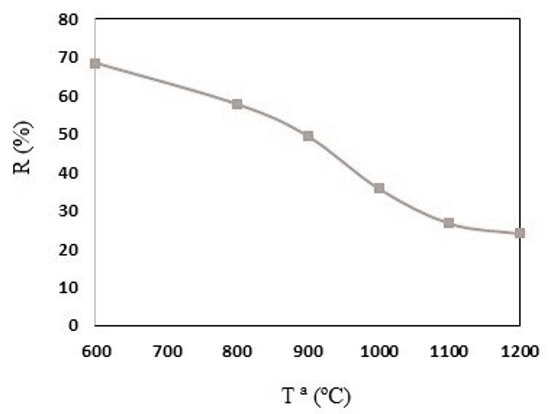
When a temperature above 1000ºC is used, a significant change occurs in the final carbon materials. Specifically, at 1100ºC these materials acquire a catalytic activity almost identical to commercial platinum-based catalyst (see Figure 2b), both in starting potential of the reaction and in current density limit, making them clear candidates for replacing platinum-based catalysts in fuel cells. However, an increase in the heat treatment temperature above 1100ºC does not lead to an improvement in the catalytic activity of the synthesized material.
Regarding the number of electrons transferred, a factor related to hydrogen peroxide performance (see Figure 2a), hydrogen peroxide values below 5% have been measured in the useful working range of fuel cells (i.e. between 0.6 and 1.0 vs RHE), indicating that it prevents formation of by-products detrimental to the life-time of fuel cells.
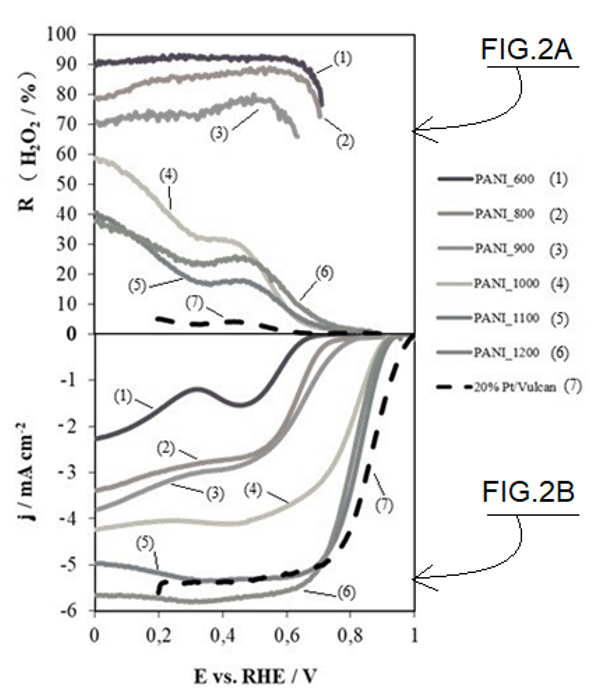
Stability was studied, and a clear improvement in the stability of the synthesized material (95%) with respect to a commercial platinum-based catalyst (87%) was observed. Moreover, its resistance to methanol poisoning has also been studied, and it has been possible to conclude that, after adding methanol up to a concentration of 1 M, the synthesized catalyst works without losing catalytic activity, while commercial platinum-based catalyst was quickly poisoned and lost its catalytic activity in the presence of methanol (see Figure 3).
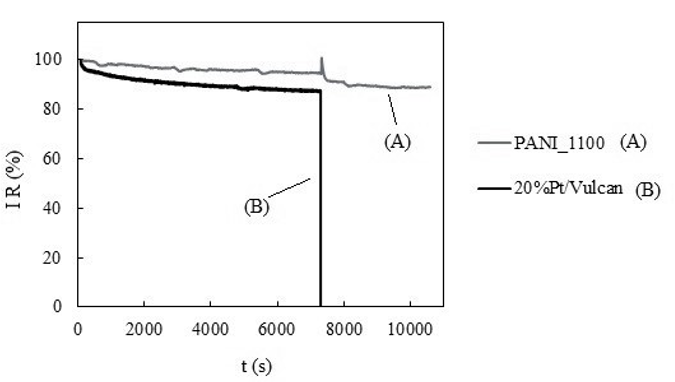
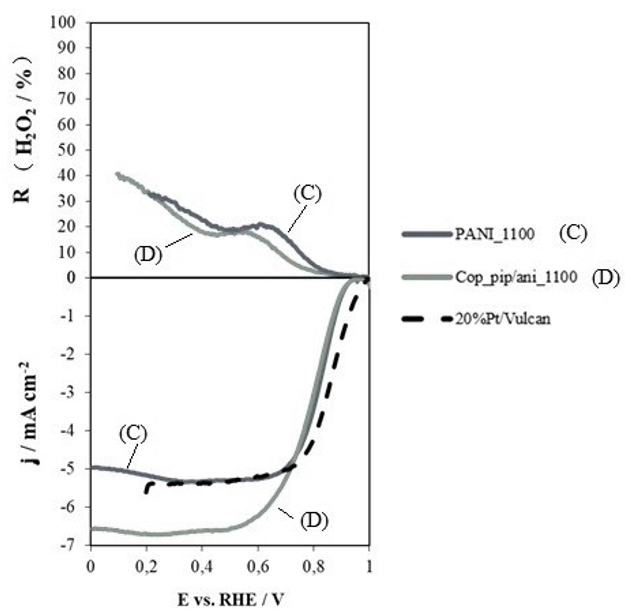
Regarding the use of different inert atmospheres (argon, nitrogen, etc.) during the synthesis procedure, it can be concluded that the excellent catalytic activity of the carbon materials obtained by this method is independent of the atmosphere used (see Figure 5).
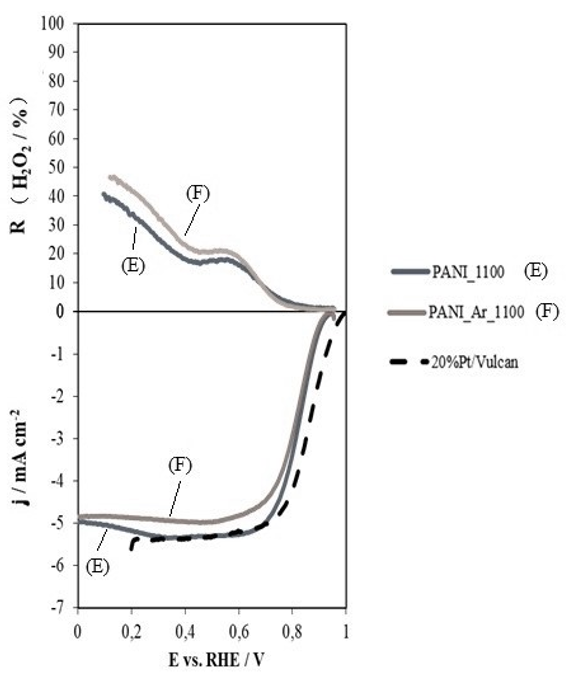
Finally, it should be underlined that the mass/flow ratio does not modify the final pyrolysis yield, nor does it affect the final catalytic activity of the materials synthesized by this method (see Figure 6).
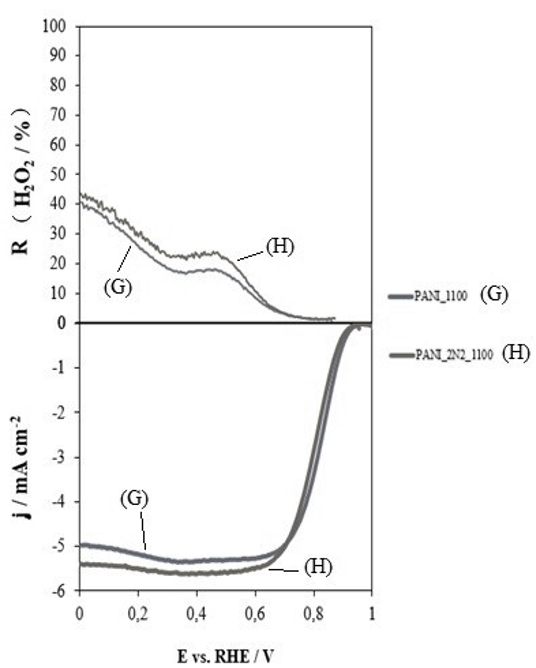
The main advantages of this novel method are listed below:
1) It uses low cost precursors.
2) It does not require special equipment.
3) They are synthesized in a very simple way and in a single-stage without using a template or sacrificial materials.
4) The synthesis method has a high yield.
5) Low cost of the synthesis method: manufacturing cost to obtain this type of materials is radically lower than current commercial catalysts.
6) Synthesized carbon materials are easy to handle: they are dispersed easily in an aqueous medium at room temperature.
7) They have an excellent electrocatalytic activity for oxygen reduction reaction in alkaline medium.
8) They have a great stability, which gives them a longer useful working time (durability) than current platinum-based electrodes of fuel cells or metal-air batteries.
9) They are resistant to methanol or carbon monoxide poisoning.
10) The oxygen reduction reaction has a high selectivity, since it is carried out through a mechanism of four electrons whose final reaction product is water (with a minimum production of reaction intermediaries, less than 5%, which could damage the fuel cell).
11) They are environmentally friendly materials, since they are metal-free catalysts.
12) They can be used as electrodes in fuel cells and metal-air batteries.
13) They reduce the total cost of the fuel cell.
14) These are major candidates to replace existing commercial platinum-based catalysts in alkaline medium.
Although thermal treatment of polymers containing aniline in their monomer units is known within the state of the art, the present method differs from the other procedures in the following aspects:
1) Heat treatment temperature is higher than 1100ºC (as opposed to the other treatments, whose working temperatures are lower than 800ºC, and therefore, insufficient to achieve a catalytic activity close to that obtained by platinum-based catalysts). Through this high pyrolysis temperature, carbon materials get a structural order, electrical conductivity and catalytic activity similar to commercial platinum-based catalysts, being, therefore, excellent substitutes for these, because production cost is radically lower.
2) No templates or sacrificial structures are used (which increase the number of stages of synthesis and the cost of manufacturing the catalyst).
3) The method described in this invention is very simple and is carried out in a single-stage.
4) The adequate selection of precursors, being polyaniline and its derivatives the most appropriate for obtaining carbon materials with excellent catalytic activity in an alkaline medium (similar to commercial platinum-based catalysts).
These novel electrocatalysts have been successfully synthesized at laboratory scale using the method described above.
Kinetic parameters obtained for these new electrocatalysts, whose values are similar to those obtained by commercial platinum-based catalysts, are listed below:
• Starting potential of the reaction = 0.94 V.
• Half-wave potential = 0.85 V.
• Limiting current density = 5.8 mA.cm-2.
• Number of transferred electrons = 3.9 (determined by RRDE).
This invention is framed in the energy sector, specifically in the area related to chemical transformations derived from the transfer of electrons produced in electrocatalysts.
This technology makes it possible to obtain metal-free carbon materials for application as excellent electrocatalysts (cathode) in the oxygen reduction reaction under alkaline conditions in hydrogen or methanol low temperature fuel cells, or in metal-air batteries.
Therefore, this technology finds its application in the following industrial sectors:
• Fuel cells.
• Metal-air batteries.
• Automobile.
• Energy production and storage.
We are looking for companies interested in acquiring this technology for commercial exploitation through:
• Patent licensing agreements.
• Development of new applications.
• Agreements regarding technology and knowledge transfer.
Company profile sought:
1) Manufacturers of catalysts and electrocatalysts for fuel cells.
2) Manufacturers of catalysts and electrocatalysts for metal-air batteries.
This invention is protected by patent:
• Title of the patent: "Procedimiento de síntesis de materiales carbonosos para su aplicación como electrocatalizadores y material obtenido por medio de dicho procedimiento".
• Application number: P201830278.
• Application date: 21st March, 2018.
Materials and Nanotechnology
Chemical Technology
Transport and Automotive
Carretera San Vicente del Raspeig s/n - 03690 San Vicente del Raspeig - Alicante
Tel.: (+34) 965 90 9959





